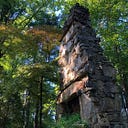The Narratives of History in “Killadelphia”: Part II
In my last post, I started looking at the differing perspectives we get of Jupiter’s history in Rodney Barnes and Jason Shawn Alexander’s Killadelphia. Specifically, I began to examine Jupiter’s description of his past in juxtaposition to the perspectives of Abigail Adams and Thomas Jefferson. After killing Blake Scott on stage during a concert, Jupiter turns himself in to the police so he can infiltrate the prison and turn incarcerated individuals and others into vampires for Abigail’s army. Before he does this, he sits in his cell in Abigail's house, with his wrists and ankles shackled and a spit guard over his mouth, he begins to tell his journey to this moment and how the knowledge of that journey, while not causing us to condone his actions, will provide context for what he has done and will also begin to “make sense” to us. His story focuses on the psychological trauma of enslavement and his continued, long after the end of enslavement, dehumanization whereas Jefferson’s and Abigail’s retelling of Jupiter’s story present him as willfully subjecting to his position until Abigail frees him.
Issue #9 opens with a five-page panel depicting Jupiter sitting in the jail cell as he…
